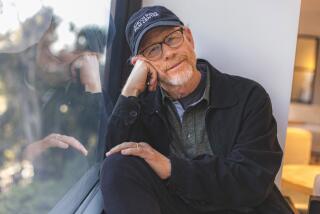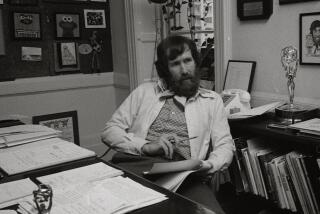From the Archives: Jim Henson Dies at Age 53; Muppets’ Creative Genius
Jim Henson, creator of Kermit the Frog, Miss Piggy and the other Muppets who entertained and educated millions of preschoolers and their parents around the world, died early Wednesday of pneumonia. He was 53.
Henson died in New York Hospital in Manhattan, where he had been taken to the emergency room less than 24 hours earlier suffering from “acute respiratory distress and symptoms of pneumonia,” hospital spokesmen said.
They described the cause of death as “a massive bacterial infection, more specifically known as streptococcus pneumonia.”
Arthur Novell, spokesman for Jim Henson Productions, said Henson had neglected to seek treat ment until it was too late. An autopsy indicated the infection had been raging through Henson’s body for at least three days.
“Tragically, the acute infection had already progressed to such an extent that he had multiorgan failure: kidney failure, inability of the blood to clot, heart failure, and shock,” the hospital said. “At this stage, (high-dose) antibiotics could not reverse the process.”
Henson, who claimed he became a puppeteer by accident, last year sold many of his more than 200 Muppet characters and his New York-based Henson Associates Inc. to Walt Disney Co. for an estimated $150 million to $200 million. The sale included a 15-year contract for the creative services of Henson, who said he had once wanted to be a Disney animator.
“Michael Eisner, Frank Wells and all who work at the Walt Disney Co. are profoundly shocked and saddened by the untimely death of Jim Henson,” Disney executives said in a statement.
“The world has lost a creative genius and a warm and gentle man. We grieve with his family and share their great loss. We vow to do all that we can to see that the extraordinary legacy of this great friend and colleague will live on.”
Henson’s Muppet credits included “Sesame Street,” introduced for preschoolers by Children’s Television Workshop on educational stations in 1969 and now seen in more than 80 countries; “The Muppet Show,” which ran from 1976 to 1981, won three Emmys and became the world’s most widely watched television program, with 235 million viewers in more than 100 countries; the series “Fraggle Rock” and “The Ghost of Faffner Hall” for cable; three movies, “The Muppet Movie” in 1979, “The Great Muppet Caper” in 1981 and “The Muppets Take Manhattan” in 1984, and the Saturday morning animated “Jim Henson’s Muppet Babies,” now in its sixth season with four Emmys and healthy ratings.
This year his clever costuming helped create new box-office magic with the film “Teenage Mutant Ninja Turtles.”
The bearded, graying Henson last fall appeared as himself on “The Jim Henson Hour.” Times television columnist Howard Rosenberg described the short-lived series, which won Henson another Emmy, as “a happy, imaginative, cleverly written, fur-flying romp.”
“As usual,” Rosenberg wrote, “Muppeteering yields entertainment on two levels: visual for the young and satirical for adults.”
James Maury Henson was born Sept. 24, 1936, in Greenville, Miss., where his father, Paul, was an agronomist with the U.S. Department of Agriculture. The family soon moved to Hyattsville, Md., a suburb of Washington, D.C., where Henson grew up and, with only casual interest, joined a high school puppet club.
How he moved from a hobby with puppets to a career with Muppets--the word he coined for his combining of marionettes and puppets--also occurred without design.
“It was the early 1950s and I was between high school and college and needed a job,” he said. “There was this job available for a puppeteer on a local NBC station in Washington. I figured it would be a pretty good job, so I applied for it and got it.”
He kept the job while he studied acting, staging and scenic design at the University of Maryland.
During his freshman year, two events occurred that further shaped Henson’s life: He acquired a five-minute local television show of his own called “Sam and Friends,” which led into Johnny Carson’s “Tonight Show.” The show continued for eight years and in 1958 won a local Emmy, which finally convinced Henson to make his career manipulating socks and rag dolls.
Until then, he once explained, “I mean, it didn’t seem to be the sort of thing a grown man works at for a living.”
The second event came during his freshman year, when he met art student Jane Nebel, who became his puppeteering partner on the show, and, in 1959, his wife. She continued to work Muppets while raising their five children--Lisa, Cheryl, Brian, John and Heather.
Henson created Kermit the Frog, whom he described as “a normal person in the middle of a bunch of crazies,” for that local show. But it was Rowlf, a Muppet dog created originally for a dog food commercial, that first attracted national attention.
Rowlf became a regular on television’s “Jimmy Dean Show,” and the growing Muppet gang was soon guesting on “The Ed Sullivan Show,” “Today” and “Tonight.”
“Sesame Street” where Big Bird, Ernie and the Cookie Monster helped teach 3- to 5-year-olds their numbers, the alphabet, and geometric shapes, made Muppets a household word. (Henson co-owned the “Sesame Street” Muppets with Children’s Television Workshop and did not sell or release those characters to Disney.)
Henson considered the three most important factors in nurturing children, including his own, to be home, school and television.
“Kids love to learn,” he said. “And the learning should be exciting and fun. That’s what we’re out to do.”
Although Henson’s Muppets are large--Big Bird is eight feet tall--they are basically hand puppets sculpted out of foam rubber and covered with fleecy materials like wool or flannel. As opposed to “old-fashioned” wooden puppets, he made them soft and flexible with large, over-biting mouths. Most can be managed by one person, who also provides the voice. Henson, for example, manipulated and spoke for Kermit and Ernie, among others.
The Muppets have earned Henson a Peabody for excellence in children’s programming and a Grammy for a record album. Henson’s voice may best be remembered as Ernie on the hit single “Rubber Duckie.”
Henson stretched his talents to animation and other creative media. In 1965, he wrote, produced, directed and starred in a short experimental film, “Timepiece,” which won an Academy Award nomination. His later non-Muppet efforts, such as the 1982 film “The Dark Crystal” and the 1986 film “Labyrinth,” were far less successful.
But puppeteering, the career he didn’t know he wanted, gave him his greatest accolades and his greatest satisfaction.
“When you do puppets,” he once said, “you can create the whole show yourself--write it, perform it, direct it, design it. Everything. It’s a whole thing, a mood. . . . I try to keep it entertaining, and then humorous.
“Also,” he added, “puppetry is a good way of hiding.”
Henson is survived by his wife and children.
A memorial service is to be announced.
From the Archives: Rita Hayworth, ‘Love Goddess’ of ‘40s, Dies
From the Archives: Perry Como, Soothing Pop Crooner, Dies at 88
From the Archives: Bette Davis Dies in Paris at 81
From the Archives: Frank Sinatra, Premier Vocalist of His Time, Dies at 82
From the Archives: James Cagney, Legend of Movies, Dies at 86
More to Read
Start your day right
Sign up for Essential California for the L.A. Times biggest news, features and recommendations in your inbox six days a week.
You may occasionally receive promotional content from the Los Angeles Times.






